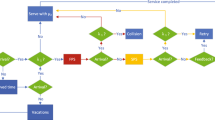Abstract
In this paper, we propose a new scheme to tackle the “beat down” unfairness problem in optical burst switching networks. In the new scheme, the control packets of bursts with higher preemptive metric value are allowed to preempt the channel resources reserved earlier for bursts with lower preemptive value. However, the control packets of preempted bursts continue to make wasted channel reservations in successive optical cross connects along the burst lightpaths and may also preempt other data bursts. Unchecked preemptions, therefore, can degrade the throughput of the network and induce reverse unfairness. Our scheme uses carefully designed constraints to avoid excessive wasted channel reservations, reduce cascaded useless preemptions, and maintain healthy throughput levels. The extensive simulation results show that the constrained preemption scheme improves fairness compared to previous methods without degrading network throughput.
Similar content being viewed by others
References
El Houmaidi, M., Bassiouni, M., & Li, G. (2003). Dominating set algorithms for sparse placement of full and limited wavelength converters in WDM optical networks. Journal of Optical Networking, 2(6), 162–177.
Zhang, H., Jue, J. P., & Mukherjee, B. (2000). A review of routing and wavelength assignment approaches for wavelength-routed optical WDM networks. SPIE Optical Networks Magazine, 1(1), 47–60.
Thiagarajan, S., & Somani, A. K. (2000). Capacity fairness of WDM networks with grooming capabilities. In OPTICOMM 2000 : Vol. 4233. SPIE proceedings (pp. 191–201). Dallas, October 2000. Dallas: SPIE.
Zhou, B., Bassiouni, M., & Li, G. (2005). Routing and wavelength assignment in optical networks using logical link representation and efficient bitwise computation. Journal of Photonic Network Communications, 10(3), 333–346.
El Houmaidi, M., & Bassiouni, M. (2006). Dependency based analytical model for computing connection blocking rates and its application in the sparse placement of optical converters. IEEE Transactions on Communications, 54(1), 159–168.
Qiao, C., & Yoo, M. (1999). Optical burst switching (OBS)—a new paradigm for an optical Internet. Journal of High Speed Networks, 8, 69–84.
Wei, J. Y., & McFarland, R. I. (2000). Just-in-time signaling for WDM optical burst switching networks. Journal of Lightwave Technology, 18(12), 2019–2037.
Zhou, B., Bassiouni, M., & Li, G. (2004). Improving Fairness in optical burst switching networks. Journal of Optical Networking, 3(4), 214–228.
White, J. A., Tucker, R. S., & Long, K. (2002). Merit-based scheduling algorithm for optical burst switching. In Proceedings of the international conference on optical Internet (pp. 75–77). Seoul, July 2002. Seoul: Korean Institute of Communication Sciences.
Vokkarane, V., & Jue, J. (2002). Prioritized routing and burst segmentation for QoS in optical burst-switched networks. In Proceedings of optical fiber communication conference (OFC), Anaheim, CA, March 2002. Optical Society of America.
Loi, C. H., Liao, W., & Yang, D. N. (2002). Service differentiation in optical burst switched networks. In Proceedings of IEEE Globecom, Taipei, Taiwan, November 2002. IEEE.
Yoo, M., & Qiao, C. (1998). A new optical burst switching protocol for supporting quality of service. In SPIE proceedings of conference of all-optical networking (Vol. 3531, pp. 396–405). November 1998. Boston: SPIE.
Labrador, M., & Banerjee, S. (1999). Performance of selective packet dropping schemes in multi-hop networks. In Proceedings of IEEE GLOBECOM (pp. 1604–1609). Rio de Janeiro: IEEE.
Poppe, F., Laevens, K., Michiel, H., & Molenaar, S. (2002). Quality-of-service differentiation and fairness in optical burst-switched networks. In Proceeding of Opticomm (pp. 118–124). Boston: SPIE.
Srinivasan, R., & Somani, A. K. (2002). Request-specific routing in WDM grooming networks. In Proceedings of IEEE international conference on communications (ICC 2002) (Vol. 5, pp. 2876–2880). April–May 2002. New York: IEEE.
Ogushi, I., Arakawa, S., Murata, M., & Kitayama, K. (2001). Parallel reservation protocols for achieving fairness in optical burst switching. In Proceedings of IEEE workshop on high performance switching and routing (pp. 213–217). May 2001. Dallas: IEEE.
Wang, X., Morikawa, H., & Aoyama, T. (2000). Burst optical deflection routing protocol for wavelength routing WDM networks. In Proceedings of OPTICOMM 2000 (pp. 257–266). Dallas: SPIE.
Suter, B., Lakshman, T. V., Stiliadis, D., & Choudhury, A. (1998). Design considerations for supporting TCP with per-flow queuing. In Proceedings of INFOCOMM ’98 (pp. 299–306). April 1998. San Francisco: IEEE.
Author information
Authors and Affiliations
Corresponding author
Rights and permissions
About this article
Cite this article
Zhou, B., Bassiouni, M.A. & Li, G. Using constrained preemption to improve dropping fairness in optical burst switching networks. Telecommun Syst 34, 181–194 (2007). https://doi.org/10.1007/s11235-007-9033-5
Published:
Issue Date:
DOI: https://doi.org/10.1007/s11235-007-9033-5




